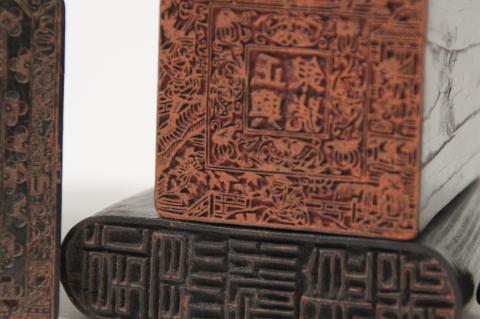Chinese Print Seals
January 1, 2018
Welcome to the new year, this month's feature is a set of Chinese print seals. They are numbered in the Dard Hunter Collection from #606 to #617. Seals were used in place of signatures on official and personal documents, on art, and even on buildings, and were traditionally printed in red. Generally, seals were carved in stone, wood, or bone, and were popularized because of their ease of use and difficulty in replication, making forgeries less common. The prints from the seals were made with inks or pastes made from the mineral cinnabar, which was ground down to produce an array of red colors. Chinese seals first came into use during the Shang Dynasty nearly four thousand years ago, around 1600's BC, and were reserved for governmental use at the time.
The seals in our collection are carved primarily in water buffalo horn and stone, and still have stains from the red pastes used for printing. Four of the six seals featured here are made from water buffalo horn, the long oval one is made from wood, and the last seal, the small square one, is stone. Some feature elaborate borders around the seal characters, while others have common motifs or symbols accompanying the characters. Each one is small enough to be easily held in one hand, often even with only two or three fingers. Some have marks indicating which side of the image is the top when printed, usually given as arrows or characters engraved on the side or the top face. The type of script used is an indicator of age - the blocky, simple scripts on the oval seal and the square seal are older seal scripts, while the other seals have modern scripts.
Since the Ming dynasty in the 1300's, China has had three major school devoted to seal making - the Zhe School, the Hui/Wan School, and the most recent one, the Hai School. Members of the Zhe school formed the Xiling Seal Engravers' Society in 1904 to protect and research the history of China's seals, and it is still active today. In the present day, seals are still in use for labeling art and signing official documents.
We hope that you enjoyed this peek at our collection! We'll be back next month with another artifact. Have a great January!
Category: Tools
Region of Origin: Asian
Keywords:
Tools

